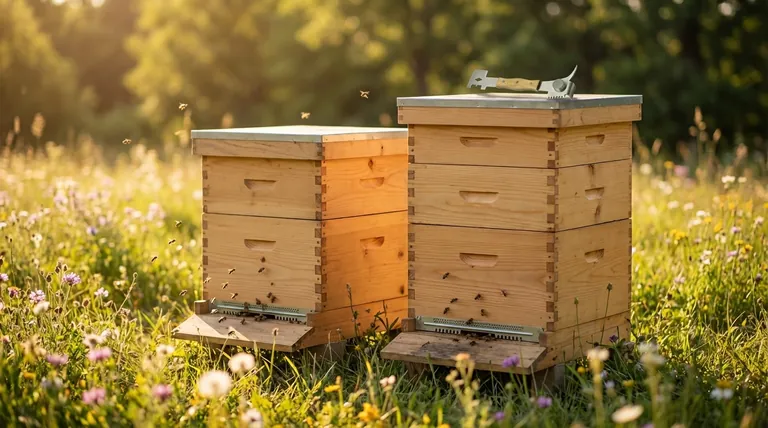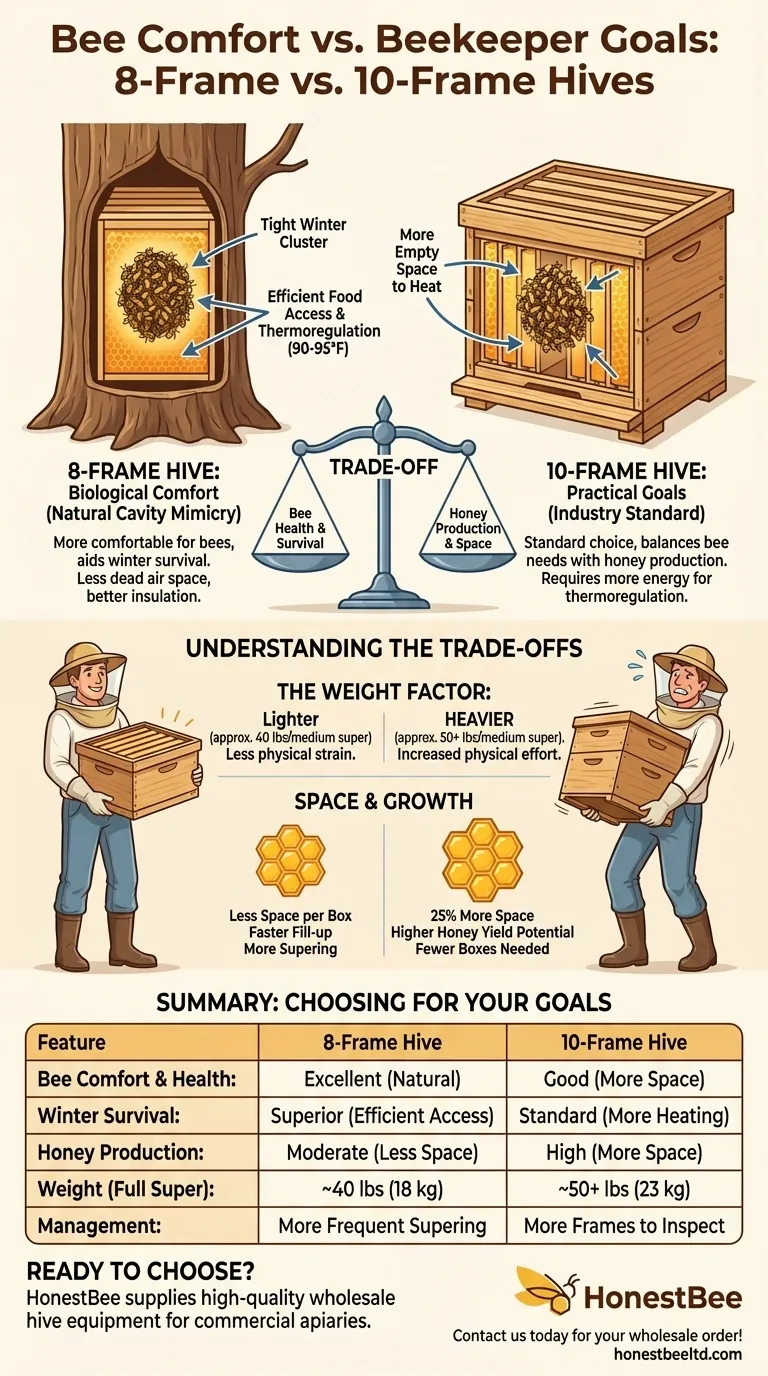From a purely biological perspective, an 8-frame hive is generally considered more comfortable for honey bees. Its narrower, more compact dimensions better mimic the vertical cavities like hollow trees where bees naturally build their nests. This shape aids in thermoregulation and makes it easier for the winter cluster to access honey stores, directly contributing to colony health and survival.
The choice between an 8-frame and a 10-frame hive is a fundamental decision that balances the bees' natural comfort against the beekeeper's goals for honey production and ease of management. Understanding this trade-off is key to selecting the right equipment.

Why a Narrower Hive Benefits Bees
The internal architecture of a hive has a significant impact on the colony's ability to regulate its environment and survive the seasons. The bees' "comfort" is a direct result of how efficiently they can manage their home.
Mimicking Natural Habitats
Wild honey bees almost always seek out tall, narrow cavities. The shape of an 8-frame hive body more closely resembles these natural preferences.
This vertical orientation encourages bees to build their comb and store resources in a way that aligns with their instincts.
The Critical Winter Cluster
During winter, bees form a tight cluster to generate and conserve heat. In a narrower 8-frame hive, this cluster has an easier time covering the frames from side to side.
As the cluster consumes honey and moves upward through the winter, this compact shape ensures they remain in contact with their food stores, reducing the risk of the colony starving just inches away from honey.
Superior Thermoregulation
A 10-frame hive contains more empty space that the bees must patrol and, more importantly, heat. This requires a significant expenditure of energy.
The cozier dimensions of an 8-frame hive mean less dead air space, providing better insulation and allowing the colony to maintain its ideal brood-rearing temperature (90-95°F or 32-35°C) with less effort.
Understanding the Practical Trade-offs
While an 8-frame hive may be better for the bees, the 10-frame hive became the industry standard for reasons that benefit the beekeeper. Your choice depends on which set of compromises you are willing to make.
The Weight Factor
This is often the most decisive factor for beekeepers. A full 8-frame medium honey super weighs around 40 pounds (18 kg), while a 10-frame equivalent can exceed 50 pounds (23 kg).
Many beekeepers switch from 10-frame to 8-frame equipment specifically to reduce the physical strain of lifting heavy boxes.
Space, Growth, and Production
A 10-frame hive offers 25% more space per box. This means more room for the queen to lay eggs and for workers to store honey.
This can lead to larger colonies and potentially higher honey yields per hive. It also means you may need fewer boxes overall compared to an 8-frame setup.
Hive Management and Inspections
Because they have less space, 8-frame hives fill up faster. This requires the beekeeper to be more vigilant about adding new boxes (supering) to provide space and prevent swarming.
An 8-frame hive will also become taller more quickly, which can create a higher tipping hazard. Conversely, a 10-frame hive requires inspecting two extra frames in every box, increasing the time spent on each inspection.
Equipment Availability
The 10-frame Langstroth is the traditional standard, and equipment is universally available. However, the 8-frame hive has grown so popular that nearly all suppliers now offer a full range of compatible components.
Making the Right Choice for Your Goals
There is no single "best" hive, only the best hive for your specific context and beekeeping philosophy.
- If your primary focus is bee health and winter survival: The 8-frame hive's shape provides a measurable advantage for the colony's natural processes.
- If your primary focus is maximizing honey production: The 10-frame hive offers more space for resources and may yield more honey with a shorter overall hive height.
- If your primary focus is reducing physical strain and heavy lifting: The 8-frame hive is the clear and immediate winner.
Ultimately, choosing your hive system is about aligning your physical abilities and management style with the needs of your bees.
Summary Table:
| Feature | 8-Frame Hive | 10-Frame Hive |
|---|---|---|
| Bee Comfort & Health | Excellent (mimics natural tree cavities) | Good (more space, less natural shape) |
| Winter Survival | Superior (easier for cluster to access honey) | Standard (more space to heat) |
| Honey Production | Moderate (less space per box) | High (25% more space per box) |
| Weight (Full Super) | ~40 lbs (18 kg) | ~50+ lbs (23 kg) |
| Management | More frequent supering needed | More frames to inspect per box |
Ready to choose the right hive for your apiary's success?
At HONESTBEE, we supply commercial apiaries and beekeeping equipment distributors with high-quality, durable 8-frame and 10-frame hive equipment through our wholesale-focused operations. Whether you prioritize bee health with our 8-frame systems or maximize production with our 10-frame options, we provide the reliable supplies you need to thrive.
Contact HONESTBEE today to discuss your hive equipment needs and place your wholesale order!
Visual Guide

Related Products
- Multi-Function Hive Tool with Integrated Hammer for Beekeeping
- Long Langstroth Style Horizontal Top Bar Hive for Wholesale
- Professional Galvanized Hive Strap with Secure Locking Buckle for Beekeeping
- Ergonomic Two Person Foldable Hive Lifter
- Plastic Bee Hive Stand for Beekeeping
People Also Ask
- What precautions should be taken when using a sharpened hive tool? Maximize Efficiency While Staying Safe
- What is the importance of understanding the function of each part of the beehive? Master Your Hive for a Thriving Colony
- What are the benefits of a universal hive? Maximize Honey Production & Apiary Resilience
- What factors should be considered when choosing a hive tool? Select the Right Tool for Your Apiary
- How often should the area under beehives be inspected and cleaned during the warm season? A Proactive Maintenance Guide



















